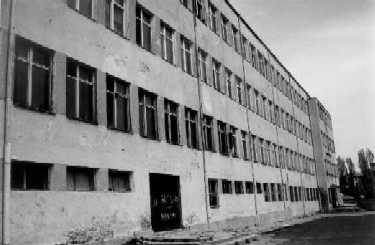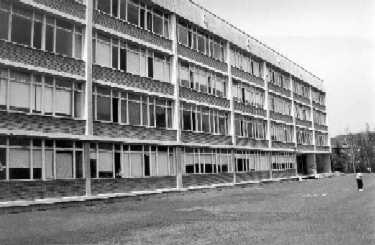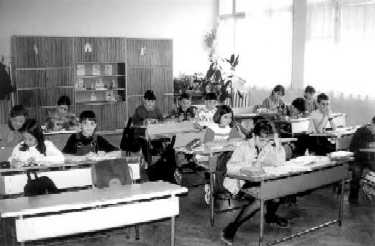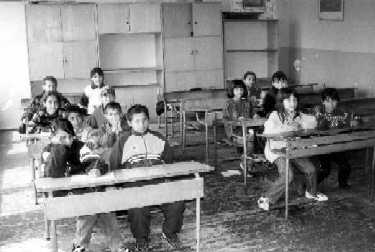Parallel worlds: Romani and non-Romani schools in Bulgaria
03 October 2000
Jennifer Tanaka1
According to the Bulgarian Constitution, education is compulsory for all children under the age of sixteen. Primary and secondary education is to be free for all citizens. The Bulgarian Law on Public Education bans discrimination in the field of education at Article 4(2). Nevertheless, the 1999 "Welcome Pupils or Gypsy Spring" documentary, by the non-governmental organisations CEGA and NOVIB, states that of an estimated 800,000 Roma in Bulgaria, about 8% are illiterate; 37% have a 4th grade education; 46% have completed primary education; 8% have finished secondary education, and less than 1% have university degrees.
There are deep-rooted and widespread negative attitudes toward Roma in the majority society and these often find expression in the schooling of Romani children. Issues such as the maintenance of lower standard vocational-oriented programs in ethnic Romani schools; transfer of Romani students to "special schools" for the mentally disabled; segregated classes for Roma and the exclusion of Romani children from ethnic Bulgarian schools and classes; and teachers' neglect of hostile acts by non-Romani students toward their Romani classmates are some of the manifestations of such attitudes and prejudices.
 Romani primary school in the town of Kurdjali. As in other Romani neighborhood schools, some students begin the first grade without sufficient knowledge of the Bulgarian language, there is a lack of books and other school materials, and health problems amongst children contribute to absenteeism. Photo: Jennifer Tanaka |
 A top or 'elite' school in the town of Kurdjali specialising in foreign languages. There is an increasing trend in the Bulgarian education system for profile-oriented schools, either beginning from the primary level or at the pre-secondary level. Usually students are required to pass an entrance exam, and the families are expected to buy the textbooks required for class subjects. Romani representation in these schools is practically zero, as Roma often lack sufficient preparation to pass entrance exams, and Romani parents often lack sufficient income to cover the costs of school books and materials needed for the classes. Photo: Jennifer Tanaka |
In the 1950's, a policy of forced settlement of nomadic and semi-nomadic Roma was accompanied by attempts by authorities to increase schooling of Roma. A number of new schools were built in the Romani settlements, and the initial results are generally viewed as having had a positive impact on literacy among Roma. However, from the mid-1960's, the quality of education offered by these Romani neighbourhood schools declined. Many Roma attended irregularly or dropped out, and a number of schools adopted an increased focus on vocational skills, replacing courses such as Bulgarian language, mathematics, foreign languages and natural sciences. The education in these schools did not adequately prepare students for advancement to higher levels of education. Until the early 1990s, many such schools were explicitly "special schools for mentally disabled children". Today, a number of formerly "special" schools have become nominally standard schools without an explicitly vocational profile, but in reality, the character of these schools has not much changed since academic standards were reduced in the 1960s.
Generally schools in the Romani neighbourhoods are old, run-down buildings, often with barbed wire on the windows, broken windows, paint peeling off the walls, and classrooms with little decoration or facilities. Some schools have toilets located in small cement structures away from the main building, and in some cases these are also used by other members of the community. An estimated 70% of the Romani children in Bulgaria attend such schools, where the quality of education is generally lower than other non-Romani populated schools. Owing largely to the fact that attending kindergarten costs money in the form of fees, and that many Romani children come from poor families, only an estimated 10-12% of Romani children attend kindergarten, and many Romani children start the first grade without adequate knowledge of the Bulgarian language. There is no state programme to address this issue. Romani pupils often lack textbooks and other school materials, and some complain openly of hunger.
The segregation of Roma into "Gypsy schools" and separate classes has been recognised in the governmental "Framework for a Program for Equal Integration of Roma in Bulgarian Society", adopted by the Council of Ministers in April 19992. The number of ethnic Bulgarian children beginning school each year is declining, meaning that there is often adequate space in the local Bulgarian schools. While there have been some local decisions to transfer Romani students to mostly ethnic Bulgarian schools, these have also been accompanied by incidents in which this desegregation effort was met with protests from Bulgarian parents and even withdrawal of their children from the school3.
In practice, the de facto segregation of Romani children in the schooling process means that they are confronted with unequal treatment at an early age. The high rates of unemployment amongst Romani adults also contribute to an unequal start as the rising costs of kindergarten fees means that fewer Romani children attend kindergarten than in previous years. Kindergarten is important for laying the foundation for the child's future education. Currently there is no effective social policy in Bulgaria to support the participation of children from low-income families and guaranteeing their ability to attend kindergarten.
Other critical stages are the transition from the 4th to the 5th grade, and the 8th to the 9th grade. In some cases, this involves a transfer from one school to another (i.e. the Romani neighborhood school to a mixed school). Where the quality of education is lower in the Romani school, students have difficulties upon transfer. Without extra support and attention, this often results in humiliation, frustration and eventual withdrawals.
 Above, a class in a profile-oriented school, specialising in foreign languages, in the town of Kurdjali. In marked contrast to the Romani neighborhood school (opposite), the building is in good condition, the rooms are well lit, there are pictures on the walls, and books on the desks of the students. Photo: Jennifer Tanaka |
 In the Romani neighborhood school in Kurdjali, 73 out of the 610 Romani and Turkish-Romani students dropped out or had to repeat the same grade in the 1998/1999 school year. Out of about 80 students who started, some 40 students completed the 8th grade in 1999. Photo: Jennifer Tanaka |
In addition to the lower quality education in the Romani neighbourhood schools, Roma are also over-represented in the so-called "special schools" for children with mental disabilities. This is a relatively well-known problem in Bulgaria, but there have been no significant efforts to halt current practices. For a number of years, it has been observed that the decrease in state subsidies for school-age children was accompanied by a rise in the proportion of Romani children in special schools. According to one report, by 1995 approximately one out of every three pupils was Romani (see Tomova, 1995: 61).
In 1999, it was reported that there were 274 special schools and institutions located both in large towns and some remote country locations4. Romani representation in these schools is unofficially estimated at about 70%. Similarly, the Regional School Inspector in the northern county of Montana estimated that more than 60% of the children in the county's special schools were of Romani origin, from families confronted with extremely difficult economic situations5.
Romani children's insufficient knowledge of the Bulgarian language may lead to their transfer to special schools, though the current economic difficulties confronting the majority of Romani families mean that the free food and materials provided to students in these schools can also be a motivating factor for parents. All special or auxiliary schools are financed fully by the Ministry of Education, unlike normal schools, which also receive partial funding from local government budgets. Nevertheless, at the end of the funding process, special schools are generally much wealthier than normal schools. For example, in comparing the budgets for all needs (materials, books, repairs, etc.), excluding teachers' salaries, one Romani neighborhood school I visited had about 1,000 Bulgarian leva (approximately 600 euro) for a school of some 650 children, while a special school in the same town had about 50,000 Bulgarian leva (approximately 30,000 euro) for some 75 children6.
The official procedure for determining whether a child should be placed in a special school involves either a committee comprising a psychologist, an educator and the child's teacher (appointed by the regional educational office), or by the issuing of a medical certificate on the child's psychological state. However, the exams are not culturally sensitive, for example, as they take place only in the Bulgarian language. There is also no clear criteria for determining the mental health of the child, and according to NGO experts working in the field, a decision is often made during assessments as short as 2-3 minutes. Finally, the commission itself is not independent, since one member of the commission is often the director of the specific school7. In the context of the current demographic trend in Bulgaria, it is clear that a number of schools will have to be closed, as the school aged population has decreased significantly. Therefore, decisions may be influenced by an interest in keeping schools open and maintaining jobs.
Local, regional and central government authorities have recognised that there are Romani children in these schools who are not mentally handicapped8. However, as no steps have been taken to correct the situation, there seems to be a lack of real political will to do anything. One foreseen change is the intention to transfer fiscal responsibility of the schools to the local governments. These may be set on reducing spending and therefore close some of the schools. However, the impact of such developments on the misplacement of Romani children in special schools is as yet unknown.
The way forward
The adoption of the "Framework for a Program for Equal Integration of Roma in Bulgarian Society" was an important first step in identifying tasks to improve the overall situation of Roma in Bulgaria, including those in the field of education. The government is now faced with making the appropriate legislative, administrative and institutional changes in view of implementing the respective policies.
While economic conditions do influence the situation - for example, in terms of family income, long-term unemployment, public services and central and local government expenditures - genuine political will is necessary for the institutionalisation of Roma-related policy provisions, and the mainstreaming of Romani issues into wider processes of educational system reforms and developments. There is a need to consider both the Romani children already in school, and those who are not attending at all.
A well-planned, well-communicated and carefully monitored process of desegregation should take place. Otherwise, it is difficult to foresee that the current situation of Roma in the Bulgarian educational system will undergo significant changes. The desegregation process should include preparatory activities for Romani and non-Romani students and parents, teachers, and school administration. Roma must be accepted in the schools by school administration and majority population parents; teachers need to be more informed about Romani culture, better prepared to work with Romani students and to address issues of inter-ethnic classroom relations; and Romani families and students must be prepared for their more meaningful engagement with majority people and institutions.
Adequate preparation is necessary for these changes. If Romani schools are immediately closed, and the Roma and ethnic Bulgarian schools not prepared to accept the students and to address inter-ethnic relations, the effects could mean even greater exclusion of Roma from schooling institutions. Romani culture, history and language should have its place within the national education curriculum, and there should be widespread access to programs that facilitate and support the participation of Roma in higher education.
NGOs in Bulgaria have to date played a leading role in identifying local problems and methods for working with Romani students, families and local schools. While such grassroots approaches should undoubtedly continue to play an important role, the situation calls for government-led systemic changes to provide Roma with equitable educational opportunities.
- Creating Effective Grassroots Alternatives Foundation and NOVIB, "Welcome Pupils or a Gypsy Spring" video, 1999.
- Council of Ministers of the Bulgarian government, "Framework for a Program for Equal Integration of Roma in Bulgarian Society", April 1999.
- Organisation for Security and Cooperation in Europe, High Commissioner on National Minorities, "Report on the Situation of Roma and Sinti in the OSCE Area", the Hague, the Netherlands, 2000.
- Penn, Helen, "Integrated Education in Bulgaria: Situational Analysis", Commissioned by Save the Children Fund UK, March 1999.
- Tomova, Ilona, "The Gypsies in the Transition Period", International Center for Minority Studies and Intercultural Relations, 1995.
Endnotes:
- Jennifer Tanaka has been a consultant to the Open Society Institute in Budapest. These photos and information were collected for the forthcoming report “Roma in the Educational System of Bulgaria — A Problem Analysis”, prepared by the author for the Institute for Educational Policy of the Open Society Institute, Budapest.
- See Council of Ministers of the Bulgarian Government, “Framework for a Program for Equal Integration of Roma in Bulgarian Society”, Section V. Section V, on “Education” is reproduced, in its entirety, immediately following this article.
- Examples include an incident in Yambol, according to a forthcoming report by the UK non-governmental organisation Save the Children.
- See Penn, Helen, “Integrated Education in Bulgaria: Situational Analysis”, commissioned by Save the Children Fund UK, March 1999, p.7.
- Interview by the author with Montana School Inspector, April 13, 2000.
- Interview by the author with school officials in Vidin, April 14, 2000.
- According to the Bulgarian Helsinki Committee (BHC), a Sofia-based non-governmental organisation, the category referred to as “special schools” in Bulgaria encompasses a range of schools and other institutions falling under the competence of either the Ministry of Education or the Ministry for Social Affairs. These include schools for moderately and severely mentally disabled children, so-called “auxiliary schools” for the mildly mentally handicapped (boarding and day academies), educational boarding schools (an institution for juvenile delinquents), and orphanages and children’s homes. According to the BHC, all of these schools and institutions have a marked over-representation of Romani children (interview by the author, September 15, 2000).
- Interviews by the author with officials in Lom, Montana and Sofia, April 2000.




